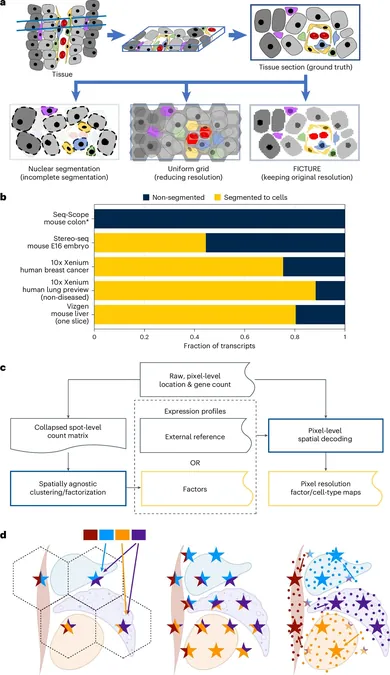
Groundbreaking Algorithm Unveils Gene Expression with Unprecedented Clarity!
2024-10-31
Author: Siti
Revolutionary Technique in Biological Sciences
A revolution in the biological sciences is upon us! Researchers at the University of Michigan have unveiled a cutting-edge technique that allows scientists to visualize gene expression in extraordinary detail. This new method, called Seq-Scope, is set to transform our understanding of genetic behavior at a microscopic level.
Seq-Scope: A New Era of Gene Expression Analysis
Originally introduced in the prestigious journal *Cell* in 2021, Seq-Scope offers the first-ever means to analyze gene expression at a sub-micrometer scale. For context, this level of resolution surpasses the thickness of a single human hair, which ranges from 20 to 200 micrometers.
Enhancements and Innovations
The latest enhancements to Seq-Scope, detailed in *Nature Protocols*, have made this innovative tool more versatile and user-friendly than ever before. In tandem, the research team has launched FICTURE, an innovative algorithm developed for high-resolution spatial data analysis derived from Seq-Scope and other sequencing technologies. This pioneering work was shared in *Nature Methods*.
“Essentially, we’re reprogramming DNA sequencing machines to automate the heavy lifting involved in this research,” explained Hyun Min Kang, a biostatistics professor at U-M School of Public Health.
The Power of Transcriptome Data
The Seq-Scope method leverages these machines to yield transcriptome data—an aggregate of all RNA transcriptions present in a given cell or tissue sample. Traditionally, analyzing gene expression has been a daunting task due to the vast number of genes, often numbering in the tens of thousands, making computational help essential for deciphering the data from millions of cells.
“Historically, there hasn’t been a computational method capable of interpreting this data at such a microscopic level,” stated Jun Hee Lee, a professor in Molecular & Integrative Physiology at U-M Medical School.
High-Precision Spatial Transcriptomes
The achievements of Lee and Kang have made it possible to repurpose sequencing technology to deliver high-precision spatial transcriptomes, giving researchers insight into the precise locations and expressions of genes within tissues.
Cost Reduction and Accessibility
One of the most significant advancements involves reducing the cost of high-resolution transcriptome profiling from over $10,000 to a mere $500, democratizing access to this powerful technology.
The new FICTURE method enhances data analysis by consolidating surrounding data to generate clearer insights at the micrometer scale. This allows researchers to accurately identify where cellular transcripts exist, free from bias.
Real-World Applications and Insights
For example, rather than vague descriptions, a conventional analysis might yield unclear results even when using cell segmentation techniques. Using FICTURE, researchers can now observe the differentiation process of skeletal muscle tissue in developing mouse embryos, as they evolve from myoblast cells into elongated striated muscle fibers.
Scientific Community Response
The innovation has captured the attention of many in the scientific community, prompting numerous inquiries from companies and researchers who once doubted the feasibility of conducting such experiments. Lee remarked, “Many now see this as a genuine possibility.”
Collaboration for Advancement
Additionally, the University of Michigan’s Advanced Genomics Core has contributed to the Seq-Scope protocol, refining the use of DNA sequencers and striving to enhance accessibility to this significant advancement for both U-M and the greater research community.
“Our mission is to empower researchers with the latest spatial transcriptomics technologies,” said Olivia Koues, Ph.D., Director of the Advanced Genomics Core.
Future Aspirations
Looking ahead, Lee and Kang aspire to further refine the accessibility of their methods, paving the way for increased research into genomic expression from inception to conclusion.
“This collaboration between computational and experimental scientists is essential for generating innovative data and methodologies,” concluded Kang.
Conclusion
Don’t miss out—this development could redefine genetics research and the very nature of biological studies! Stay tuned for more groundbreaking updates from the realm of science!




 Brasil (PT)
Brasil (PT)
 Canada (EN)
Canada (EN)
 Chile (ES)
Chile (ES)
 España (ES)
España (ES)
 France (FR)
France (FR)
 Hong Kong (EN)
Hong Kong (EN)
 Italia (IT)
Italia (IT)
 日本 (JA)
日本 (JA)
 Magyarország (HU)
Magyarország (HU)
 Norge (NO)
Norge (NO)
 Polska (PL)
Polska (PL)
 Schweiz (DE)
Schweiz (DE)
 Singapore (EN)
Singapore (EN)
 Sverige (SV)
Sverige (SV)
 Suomi (FI)
Suomi (FI)
 Türkiye (TR)
Türkiye (TR)